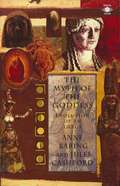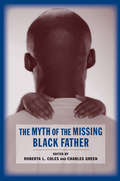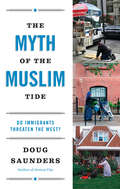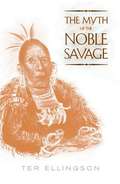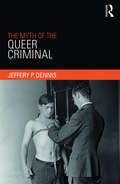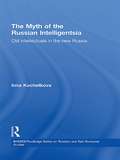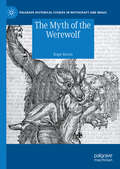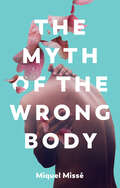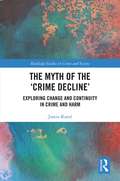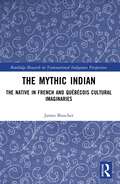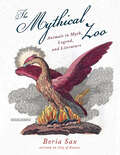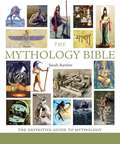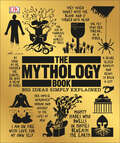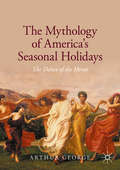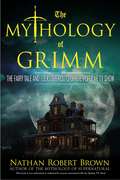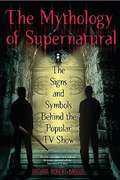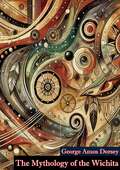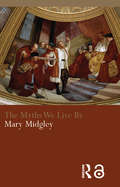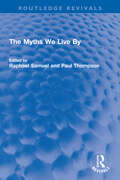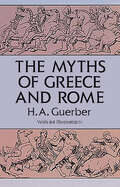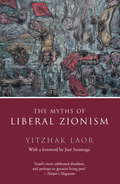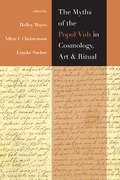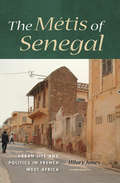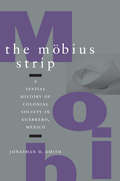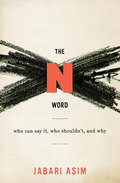- Table View
- List View
The Myth of the Goddess: Evolution of an Image
by Jules Cashford Anne BaringA comprehensive, scholarly accessible study, in which the authors draw upon poetry and mythology, art and literature, archaeology and psychology to show how the myth of the goddess has been lost from our formal Judeo-Christian images of the divine. They explain what happened to the goddess, when, and how she was excluded from western culture, and the implications of this loss.
The Myth of the Missing Black Father
by Charles Green Roberta ColesCommon stereotypes portray black fathers as being largely absent from their families. Yet while black fathers are less likely than white and Hispanic fathers to marry their child's mother, many continue to parent through cohabitation and visitation, providing caretaking, financial, and other in-kind support. This volume captures the meaning and practice of black fatherhood in its many manifestations, exploring two-parent families, cohabitation, single custodial fathering, stepfathering, noncustodial visitation, and parenting by extended family members and friends. Contributors examine ways that black men perceive and decipher their parenting responsibilities, paying careful attention to psychosocial, economic, and political factors that affect the ability to parent. Chapters compare the diversity of African American fatherhood with negative portrayals in politics, academia, and literature and, through qualitative analysis and original profiles, illustrate the struggle and intent of many black fathers to be responsible caregivers. This collection also includes interviews with daughters of absent fathers and concludes with the effects of certain policy decisions on responsible parenting.
The Myth of the Muslim Tide: Do Immigrants Threaten the West?
by Doug SaundersFrom the author of prize-winning Arrival City, a controversial and long-overdue rejoinder to the excessive fears of an Islamic threat that have spread throughout America and Europe and threaten our basic values. Since September 11, 2001, a growing chorus has warned that Western society and values are at risk of being overrun by a tide of Islamic immigrants. These sentiments reached their most extreme expression in July 2011, with Anders Breivik's shooting spree in Norway. Breivik left behind a 1500 page manifesto denouncing the impact of Islam on the West, which showed how his thinking had been shaped by anti-immigrant writings that had appeared widely in books and respectable publications. In The Myth of the Muslim Tide, Doug Saunders offers a brave challenge to these ideas, debunking popular misconceptions about Muslims and their effect on the communities in which they live. He demonstrates how modern Islamophobia echoes historical responses to earlier immigrant groups, especially Jews and Catholics. Above all, he provides a set of concrete proposals to help absorb these newcomers and make immigration work. The most important trend of the twenty-first century will be a massive global migration to cities and across international borders. Rather than responding to our new religious-minority neighbours with fear and resentment, this book shows us how we can make this change work to our advantage.
The Myth of the Noble Savage
by Terry Jay EllingsonA philosophical and cultural history of the myth of the "noble savage," one of anthropology's oldest and most successful hoaxes which people still believed today, almost a century and a half since its creation.
The Myth of the Queer Criminal
by Jeffery P DennisThe Myth of the Queer Criminal documents over a century of writings by sociologists, psychologists, criminologists, and forensic scientists, in Europe and the United States, who asserted that LGBT persons were innately and uniquely criminal. Applying the tools of narratology and queer theory, Jeffery P. Dennis examines the ten types of queer criminal that have appeared in seminal texts, both literary and scientific, over the past 140 years - beginning with Lombroso's Criminal Man (1876) and extending to postmodern criminologists and contemporary textbooks. Each type is named after its defining characteristic. The pederast, for example, was believed to be a master-criminal, leading vast criminal empires. The degenerate, intellectually and morally corrupted, was perceived as a symptom or cause of societal decay. The silly, lisping pansy was a figure of ridicule, rather than of dread. The traitor was murderous and depraved, prepared to destroy democratic institutions worldwide. The book aims to contextualize this mythology, revealing the motivations of the agents behind it, the influence of broader preoccupations and anxieties of the age, and its societal, political and cultural impact. This carefully researched, meticulously written history of the queer criminal will be of interest to students and researchers in criminology, gender studies, queer studies, and the history of sexuality.
The Myth of the Russian Intelligentsia: Old Intellectuals in the New Russia (BASEES/Routledge Series on Russian and East European Studies)
by Inna KochetkovaRussia is one of the few countries in the world where intellectuals existed as a social group and shared a unique social identity. This book focuses on one of the most important and influential groups of Russian intellectuals - the 1960s generation of shestidesyatniki - often considered the last embodiment of the classical tradition of the intelligentsia. They devoted their lives to defending 'socialism with a human face', authored Perestroika, and were subsequently demonised when the reforms failed. It investigates how these intellectuals were affected by the transition to the new post-Soviet Russia, and how they responded to the criticism. Unlike other studies on this subject, which view the Russian intelligentsia as simply an objectively existing group, this book portrays the intelligentsia as a cultural story or myth, revealing that the intelligentsia's existence is a function of the intellectuals' abilities to construct moral arguments. Drawing from extensive original empirical research, including life-story interviews with the Russian intellectuals, it shows how the shestidesyatniki creatively mobilised the myth as they attempted to repair their damaged public image.
The Myth of the Werewolf (Palgrave Historical Studies in Witchcraft and Magic)
by Roger BartraThis is a historical and anthropological study of the myth of the werewolf aimed at reflecting on the metamorphoses of evil and understanding the long evolution of a mythical structure. Legends and folklore allow us to explore the brutal bestiality of a figure loaded with sexuality, eroticism, and desire. From ancient times to the present day, the tragic narrative universe of a strange and dangerous wild world is unfolded, with elements of tenderness, that has contributed to defining the profile of civilization as its opposite. The myth was contaminated with religious fanaticism when werewolves were persecuted and burned during the times of the witch hunts.
The Myth of the Wrong Body
by Miquel MisseThe most popular narrative about transsexuality suggests that some people are born in the wrong body – that their bodies do not correspond to their inner experience and that their bodies should therefore be transformed. But in the view of the sociologist and trans activist Miguel Missé, this narrative is a harmful myth. It is rooted in a medical paradigm that typically leads to medical intervention – to the use of hormones and surgical operations. By proposing a particular solution (modifying one&’s body), doctors and psychiatrists make it difficult for trans people to overcome malaise about their body in other ways and prevent them from recognizing the burden of social norms. Drawing on his own personal experience, Missé makes the case for a different way of thinking about trans embodiment which focuses on gender identity. The trajectory that leads people to become trans is shaped by the rigidity of gender norms, where the only two models available to individuals are the masculine man and the feminine woman. But these are not the only possible choices, and by critically interrogating the rigidity of gender norms, Missé opens up a different way of thinking about being trans, beyond the essentialism of the medical paradigm.
The Myth of the ‘Crime Decline’: Exploring Change and Continuity in Crime and Harm (Routledge Studies in Crime and Society)
by Justin KotzéThe Myth of the ‘Crime Decline’ seeks to critically interrogate the supposed statistical decline of crime rates, thought to have occurred in a number of predominantly Western countries over the past two decades. Whilst this trend of declining crime rates seems profound, serious questions need to be asked. Data sources need to be critically interrogated and context needs to be provided. This book seeks to do just that. This book examines the wider socio-economic and politico-cultural context within which this decline in crime is said to have occurred, highlighting the changing nature and landscape of crime and its ever deepening resistance to precise measurement. By drawing upon original qualitative research and cutting edge criminological theory, this book offers an alternative view of the reality of crime and harm. In doing so it seeks to reframe the ‘crime decline’ discourse and provide a more accurate account of this puzzling contemporary phenomenon. Additionally, utilising a new theoretical framework developed by the author, this book begins to explain why the ‘crime decline’ discourse has been so readily accepted. Written in an accessible yet theoretical and informed manner, this book is a must-read for academics and students in the fields of criminology, sociology, social policy, and the philosophy of social sciences.
The Mythic Indian: The Native in French and Québécois Cultural Imaginaries (Routledge Research in Transnational Indigenous Perspectives)
by James BoucherThe Mythic Indian: The Native in French and Québécois Cultural Imaginaries charts a genealogy of French and Québécois visions of the Amerindian. Tracing an evolution of paradigms from the sixteenth century to present, it examines how the myths of the Noble, Ignoble, and Ecological Savage as well as the Vanishing Indian and Going Native inform a variety of discourses and ways of thinking about Québécois culture. By analyzing mythic depictions of the Native Figure that originate at first contacts, this book demonstrates that an inextricable link exists between discourses as disparate as literature and science.This book will be of interest to scholars in French Studies, Francophone Studies, Indigenous Studies, Hemispheric Studies, Social Sciences, and Literary Studies.
The Mythical Zoo: Animals in Myth, Legend, and Literature
by Boria SaxA beautifully illustrated alternate taxonomy of the animal kingdom, based on mythology, literature, art, and other cultural realms: &“Charming.&” —ForeWord Sacred cows, wily serpents, fearsome lions, elegant swans, busy bees, and sly foxes—all are caricatures of the creatures themselves, yet they reflect not only how different cultures see the natural world around them but also how such cultures make use of their native animals. In this fun and thought-provoking book, historian and animal enthusiast Boria Sax argues for a classification of animals that goes beyond the biological to encompass a more meaningful distinction: tradition. From ants and elephants to tigers and tortoises, The Mythical Zoo weaves together a cross-cultural tapestry encompassing mythology, history, art, science, philosophy, and literature. The result is a beautifully illustrated, masterfully composed love letter to the animal kingdom.
The Mythology Bible: The Definitive Guide to Legendary Tales
by Sarah BartlettThe world's most fascinating gods and goddesses come to life in the pages of this beautifully illustrated book. The Mythology Bible explores the powerful figures that have compelled us for millennia--including Indra, god of thunder in India's Rig Vedas; Thor, the merciless Nordic giant-slayer; and Mawu-Lisa, whom the African Fon people associate with fertility and compassion. Discover, too, the enduring themes that loom large in the myths of almost every culture: creation and the cosmos, beasts and monsters, death and the underworld, love and heroism. Filled with photographs and pictures, this volume is as attractive as it is readable.
The Mythology Book: Big Ideas Simply Explained (DK Big Ideas)
by DKLearn about compelling worlds and characters depicted in myths and legends in The Mythology Book.Part of the fascinating Big Ideas series, this book tackles tricky topics and themes in a simple and easy to follow format. Learn about Mythology in this overview guide to the subject, great for novices looking to find out more and experts wishing to refresh their knowledge alike! The Mythology Book brings a fresh and vibrant take on the topic through eye-catching graphics and diagrams to immerse yourself in. This captivating book will broaden your understanding of Mythology, with:- More than 80 classics retold and explained in mythology- Packed with facts, charts, timelines and graphs to help explain core concepts- A visual approach to big subjects with striking illustrations and graphics throughout- Easy to follow text makes topics accessible for people at any level of understandingThe Mythology Book lets you delve into each myth, discover the meanings behind them, and understand their significance to different cultures worldwide - aimed at adults with an interest in the subject and wanting to gain more of an overview. Here you&’ll find global coverage of world myths, profiling everything from the well-known tales of the Greeks, Norsemen, and Egyptians to the legends of the Caribbean, the Americas, Oceania, and East Asia.Your Mythological Questions, Simply ExplainedLearn about myths in this essential guide, from early creation beliefs to classical hero narratives and the recurring theme of the afterlife. Delve into each myth and discover the meanings behind these stories, getting to the heart of their significance to different cultures worldwide. If you thought it was difficult to learn about the many classic stories, The Mythology Book presents key information in an easy to follow layout. Discover Zeus, god of the sky and ruler of the Olympian gods, Loki, the cunning trickster with a knack for causing havoc, Thor with his mighty hammer, and Hades, ruler of the underworld - and much more.The Big Ideas SeriesWith millions of copies sold worldwide, The Mythology Book is part of the award-winning Big Ideas series from DK. The series uses striking graphics along with engaging writing, making big topics easy to understand.
The Mythology of America's Seasonal Holidays: The Dance of the Horae
by Arthur GeorgeEvery year we celebrate a cycle of seasonal holidays. The ancient Greeks called this cycle “The Dance of the Horae,” after the mythical divinities who represented the seasons. What myths sit at the foundation of our own holiday celebrations? This interdisciplinary book explores the myths and symbols that underlie our major seasonal holidays and give them their meaning. Arthur George also shows how America’s own mythmaking has shaped some holidays. This mythological approach reveals how and why holidays arose in the first place, how and why they have changed over the centuries, why they have remained important, and finally how we can celebrate them today in a more meaningful manner that can enrich our lives and better our society. George devotes particular attention to the depth psychological aspects of holidays and their corresponding myths, as well as to the insights of modern biblical scholarship for key holidays such as Easter and Christmas.
The Mythology of Grimm
by Nathan Robert BrownGET INSIDE GRIMM. NBC's hit television series Grimm pits modern detective Nick Burkhardt of the Portland Police against a cast of terrifying villains--lifted directly from the pages of classic fairytales. In the world of the show, the classic stories are actually a document of real events, and Nick himself is descended from a long line of guardians, or Grimms, charged with defending humanity from the mythological creatures of the world. From The Big Bad Wolf to Sleeping Beauty, The Mythology of Grimm explores the history and folkloric traditions that come into play during Nick's incredible battles and investigations--tapping into elements of mythology that have captured our imaginations for centuries.
The Mythology of Supernatural
by Nathan Robert BrownA look into the paranormal legends and lore features on the hit television show Supernatural. From angels to demons, The Mythology of Supernatural explores the religious roots and the ancient folklore of the otherworldly entities that brothers Sam and Dean Winchester face on the hit television show Supernatural-and that have inhabited the shadows of human imagination across countless cultures and centuries.
The Mythology of the Wichita
by George Amos Dorsey"The Mythology of the Wichita" by George Amos Dorsey is a comprehensive and illuminating exploration of the rich mythological traditions of the Wichita people, a Native American tribe originally from the Great Plains. Dorsey, a distinguished anthropologist and ethnographer, presents an extensive collection of Wichita myths, offering readers a profound insight into their spiritual beliefs, cultural values, and historical experiences.In this seminal work, Dorsey meticulously documents a wide array of myths, ranging from creation stories and tales of heroic deeds to legends that explain natural phenomena and cultural practices. Each myth is presented in a clear and engaging narrative style, preserving the authenticity and oral tradition of the Wichita storytellers from whom Dorsey gathered these accounts.Dorsey's detailed commentary and analysis provide valuable context, helping readers understand the deeper meanings and cultural significance of each story. He explores the themes and motifs that recur throughout Wichita mythology, such as the importance of kinship, the interplay between humans and the natural world, and the moral lessons embedded within the tales."The Mythology of the Wichita" is not only a collection of fascinating stories but also a vital record of the Wichita people's heritage. Dorsey's work ensures that the wisdom and traditions of the Wichita are preserved for future generations, offering a window into the worldview and spiritual life of this remarkable tribe.This book is an essential resource for students of anthropology, folklore, and Native American studies, as well as for anyone interested in the diverse tapestry of human mythology. George Amos Dorsey's "The Mythology of the Wichita" stands as a testament to the enduring power of myth and the importance of cultural preservation, inviting readers to discover and appreciate the profound legacy of the Wichita people.With its rich narratives and scholarly insights, "The Mythology of the Wichita" remains a timeless and invaluable contribution to the field of Native American studies and mythology.
The Myths We Live By (Routledge Classics Ser.)
by Mary MidgleyMary Midgley argues in her powerful new book that far from being the opposite of science, myth is a central part of it. In brilliant prose, she claims that myths are neither lies nor mere stories but a network of powerful symbols that suggest particular ways of interpreting the world.
The Myths We Live By (Routledge Revivals)
by Paul Thompson Raphael SamuelFirst published in 1990, The Myths We Live By explores how memory and tradition are continually reshaped and recycled to make sense of the past from the standpoint of the present. The book makes use of the rich material of recorded life stories, with examples stretching from the transient myths of contemporary Italian school children on strike, back to the family legends of classical Greece, and the traditional storytelling of Canadian Indians. The range of examples is international and together they advocate a transformed history, which actively relates subjective and objective, past and present, politics and poetry, and highlights history as a living force in the present. The Myths We Live By will appeal to anyone interested in oral history, memory, and myth.
The Myths of Greece and Rome (Wordsworth Myth, Legend And Folklore Ser.)
by H. A. GuerberThis generously illustrated book of classical myths has become a classic itself, long prized for its simple, graphic, accurate retelling of the principal myths of Greece and Rome, and for its commentary on their origins and significance. The myths, as H. A. Guerber observes in her preface, "have inspired so much of the best thought in English literature that a knowledge of them is often essential to the understanding of what we need."But we have also come to love these stories of Pandora, of Echo and Narcissus, Orpheus and Eurydice, Jason, Hercules, Circe, Helen of Troy, and countless others for their own rich aesthetic qualities, and for their power to stir our imaginations. And today we are learning to look more closely at all mythologies for what they reveal to us of basic human nature and human aspiration.Beginning with myths involving the gods — Jupiter, Juno, Minerva, Apollo, Diana, Venus, Mercury, Mars, and others — and ending with the adventures of Ulysses and Aeneas, this rich assembly offers hours of compelling reading and abundant insight into one of the fundamental mythologies underlying Western culture. Sixty-four illustrations by such masters as Michelangelo, Raphael, Titian, Rubens, Canova, and Bernini add further classic touches to this time-honored work, which also includes an invaluable genealogical table and a map showing the location of the myths.
The Myths of Liberal Zionism
by Yitzhak LaorYitzhak Laor is one of Israel's most prominent dissidents and poets, a latter-day Spinoza who helps keep alive the critical tradition within Jewish culture. In this work he fearlessly dissects the complex attitudes of Western European liberal Left intellectuals toward Israel, Zionism and the "Israeli peace camp." He argues that through a prism of famous writers like Amos Oz, David Grossman and A.B. Yehoshua, the peace camp has now adopted the European vision of "new Zionism," promoting the fierce Israeli desire to be accepted as part of the West and taking advantage of growing Islamophobia across Europe.The backdrop to this uneasy relationship is the ever-present shadow of the Holocaust. Laor is merciless as he strips bare the hypocrisies and unarticulated fantasies that lie beneath the love-affair between "liberal Zionists" and their European supporters.
The Myths of the Popol Vuh in Cosmology, Art, and Ritual
by Holley Moyes Allen J. Christenson Frauke SachseThis volume offers an integrated and comparative approach to the Popol Vuh, analyzing its myths to elucidate the ancient Maya past while using multiple lines of evidence to shed light on the text. Combining interpretations of the myths with analyses of archaeological, iconographic, epigraphic, ethnohistoric, ethnographic, and literary resources, the work demonstrates how Popol Vuh mythologies contribute to the analysis and interpretation of the ancient Maya past. The chapters are grouped into four sections. The first section interprets the Highland Maya worldview through examination of the text, analyzing interdependence between deities and human beings as well as the textual and cosmological coherence of the Popol Vuh as a source. The second section analyzes the Precolumbian Maya archaeological record as it relates to the myths of the Popol Vuh, providing new interpretations of the use of space, architecture, burials, artifacts, and human remains found in Classic Maya caves. The third explores ancient Maya iconographic motifs, including those found in Classic Maya ceramic art; the nature of predatory birds; and the Hero Twins’ deeds in the Popol Vuh. The final chapters address mythological continuities and change, reexamining past methodological approaches using the Popol Vuh as a resource for the interpretation of Classic Maya iconography and ancient Maya religion and mythology, connecting the myths of the Popol Vuh to iconography from Preclassic Izapa, and demonstrating how narratives from the Popol Vuh can illuminate mythologies from other parts of Mesoamerica. The Myths of the Popol Vuh in Cosmology, Art, and Ritual is the first volume to bring together multiple perspectives and original interpretations of the Popol Vuh myths. It will be of interest not only to Mesoamericanists but also to art historians, archaeologists, ethnohistorians, iconographers, linguists, anthropologists, and scholars working in ritual studies, the history of religion, historic and Precolumbian literature and historic linguistics. Contributors: Jaime J. Awe, Karen Bassie-Sweet, Oswaldo Chinchilla Mazariegos, Michael D. Coe, Iyaxel Cojtí Ren, Héctor Escobedo, Thomas H. Guderjan, Julia Guernsey, Christophe Helmke, Nicholas A. Hopkins, Barbara MacLeod, Jesper Nielsen, Colin Snider, Karl A. Taube
The Métis of Senegal
by Hilary JonesThe Métis of Senegal is a history of politics and society among an influential group of mixed-race people who settled in coastal Africa under French colonialism. Hilary Jones describes how the métis carved out a niche as middleman traders for European merchants. As the colonial presence spread, the métis entered into politics and began to assert their position as local elites and power brokers against French rule. Many of the descendants of these traders continue to wield influence in contemporary Senegal. Jones's nuanced portrait of métis ascendency examines the influence of family connections, marriage negotiations, and inheritance laws from both male and female perspectives.
The Möbius Strip
by Jonathan D. AmithThe Mobius Strip explores the history, political economy, and culture of space in central Guerrero, Mexico, during the colonial period. This study is significant for two reasons. First, space comprises a sphere of contention that affects all levels of society, from the individual and his or her household to the nation-state and its mechanisms for control and coercion. Second, colonialism offers a particularly unique situation, for it invariably involves a determined effort on the part of an invading society to redefine politico-administrative units, to redirect the flow of commodities and cash, and, ultimately, to foster and construct new patterns of allegiance and identity to communities, regions, and country. Thus spatial politics comprehends the complex interaction of institutional domination and individual agency. The complexity of the diachronic transformation of space in central Guerrero is illustrated through an analysis of land tenure, migration, and commercial exchange, three salient and contested aspects of hispanic conquest. The Mobius Strip, therefore, addresses issues important to social theory and to the understanding of the processes affecting the colonialization of non-Western societies.
The N Word: Who Can Say It, Who Shouldn't, and Why
by Jabari AsimA renowned cultural critic untangles the twisted history and future of racism through its most volatile word. The N Word reveals how the term &“nigger&” has both reflected and spread the scourge of bigotry in America over the four hundred years since it was first spoken on our shores. Jabari Asim pinpoints Thomas Jefferson as the source of our enduring image of the &“nigger.&” In a seminal but now obscure essay, Jefferson marshaled a welter of pseudoscience to define the stereotype of a shiftless child-man with huge appetites and stunted self-control. Asim reveals how nineteenth-century &“science&” then colluded with popular culture to amplify this slander. What began as false generalizations became institutionalized in every corner of our society: the arts and sciences, sports, the law, and on the streets. Asim&’s conclusion is as original as his premise. He argues that even when uttered with the opposite intent by hipsters and hip-hop icons, the slur helps keep blacks at the bottom of America&’s socioeconomic ladder. But Asim also proves there is a place for the word in the mouths and on the pens of those who truly understand its twisted history—from Mark Twain to Dave Chappelle to Mos Def. Only when we know its legacy can we loosen this slur&’s grip on our national psyche.
